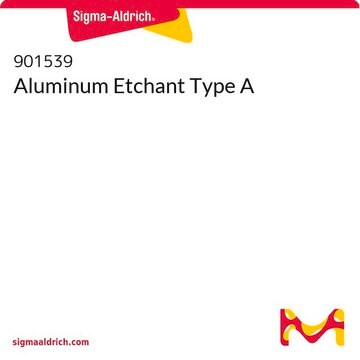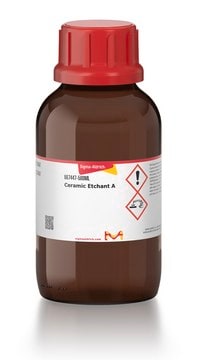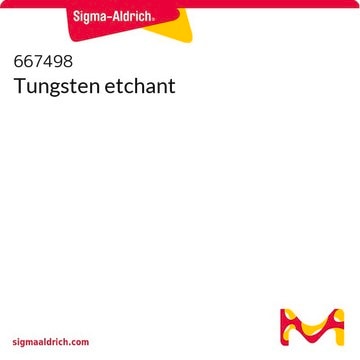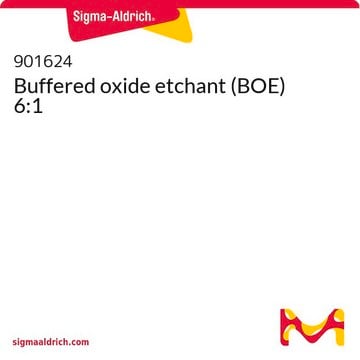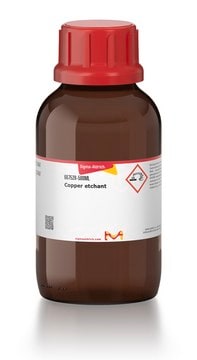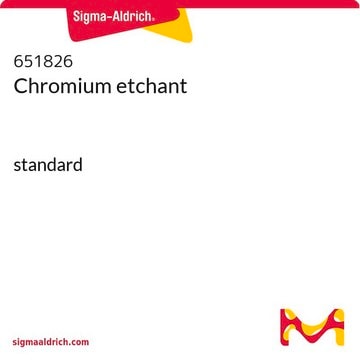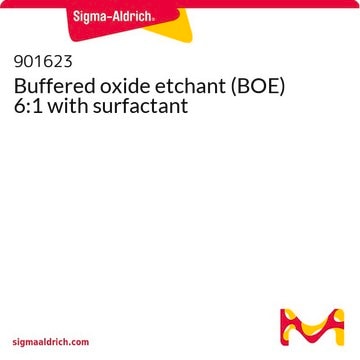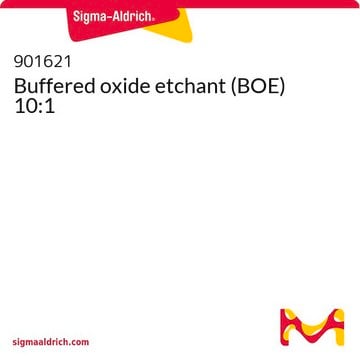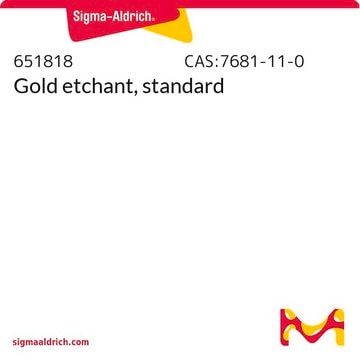901545
Aluminum Etchant Type D
Synonim(y):
Aluminum etching solution for use on gallium arsenide and gallium phosphide devices
Zaloguj sięWyświetlanie cen organizacyjnych i kontraktowych
About This Item
Kod UNSPSC:
12352311
NACRES:
NA.23
Polecane produkty
Postać
liquid
Opis ogólny
ALUMINUM ETCHANT - TYPE D
- Standard aluminum etchant for use on gallium arsenide, arsenide and gallium phosphide devices and for aluminum metallizations on nichrome resistors
- Aluminum etchants are stable, non-toxic preparations used to etch aluminum metallizations on silicon devices and in integrated circuit applications. Aluminum contacts are defined, and interconnections are formed. These Aluminum Etchants, formulated with unique properties, easily overcome many of the difficulties experienced in aluminum etch processes.
- The aluminum metallization and etching process using photo-lithographic techniques is basic to semiconductor and microelectronic technology. Aluminum etchants are highly compatible with commercial photoresists and permit delineation into high resolution patterns. Metal line width of 1 mil and separations less than 5 microns are feasible. High resolution is practical with these aluminum etchants because lifting of photoresist patterns does not occur and undercutting is minimized. Furthermore, the etchants do not attack silicon, silicon dioxide, silicon nitride or nichrome resistor films.
- Two aluminum etchants are offered for use in microelectronics. Type A is recommended for use on silicon devices. Type D is recommended for use on gallium arsenide and gallium phosphide devices to avoid attack of the etchant on the intermetallic compound. It is also recommended for etching aluminum metallizations on nichrome thin film resistors.
Zastosowanie
- Aluminum metallizations up to 25,000 Å are vacuum deposited on the silicon slice, coated with a photoresist, and UV exposed using an appropriate photographic mask. The resist is developed to protect the aluminum where interconnections are desired. Then the unprotected areas of the aluminum are removed by etching with the aluminum etchant, followed by a water rinse.
- Etching time is dependent upon the etchant temperature and the aluminum film thickness. When etching thick aluminum films, a higher etch rate is required; thus a higher etchant temperature should be used. Likewise, for thinner aluminum films, slower etch rates are desired and a lower etchant temperature should be chosen.
- At a specific etchant temperature, the etching time is given by the following formula:
where Etch Rate at 25°C 30 Å/sec; at 40°C 80 Å/sec.
Cechy i korzyści
- Controlled etch rates
- Selective etching: will not attack SiO2 or Si3N4
- Offers high resolution with minimal undercutting
- Eliminates smut formation
- Economical; reusable
This page may contain text that has been machine translated.
Hasło ostrzegawcze
Danger
Zwroty wskazujące rodzaj zagrożenia
Zwroty wskazujące środki ostrożności
Klasyfikacja zagrożeń
Acute Tox. 4 Oral - Eye Dam. 1 - Flam. Liq. 3 - Met. Corr. 1 - Skin Corr. 1B - Skin Sens. 1
Kod klasy składowania
3 - Flammable liquids
Klasa zagrożenia wodnego (WGK)
WGK 1
Certyfikaty analizy (CoA)
Poszukaj Certyfikaty analizy (CoA), wpisując numer partii/serii produktów. Numery serii i partii można znaleźć na etykiecie produktu po słowach „seria” lub „partia”.
Masz już ten produkt?
Dokumenty związane z niedawno zakupionymi produktami zostały zamieszczone w Bibliotece dokumentów.
Nasz zespół naukowców ma doświadczenie we wszystkich obszarach badań, w tym w naukach przyrodniczych, materiałoznawstwie, syntezie chemicznej, chromatografii, analityce i wielu innych dziedzinach.
Skontaktuj się z zespołem ds. pomocy technicznej